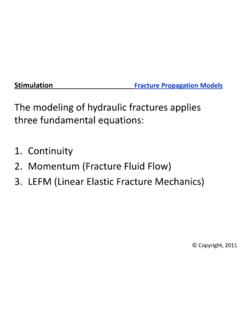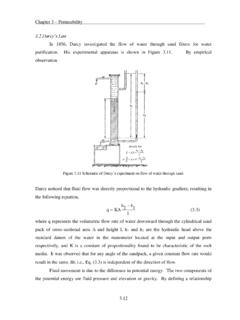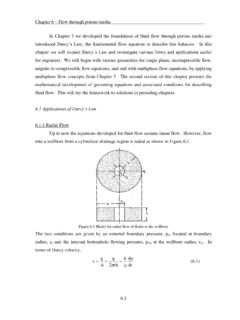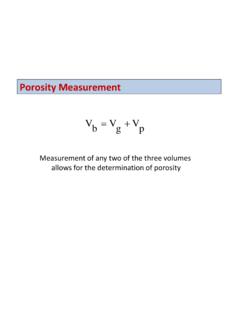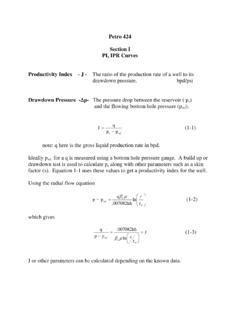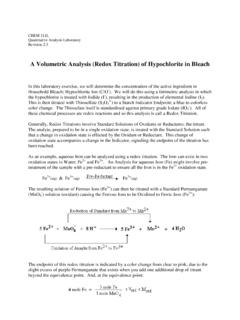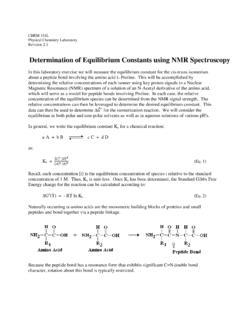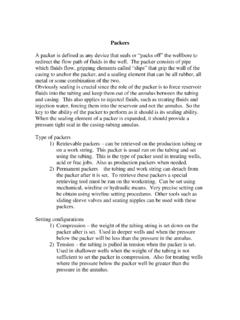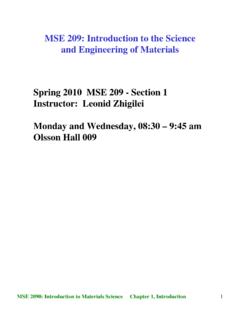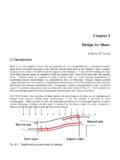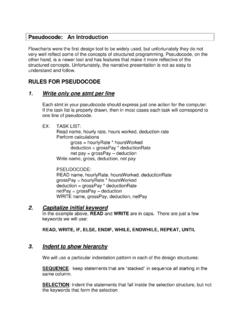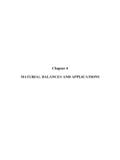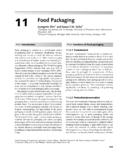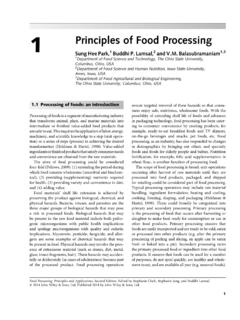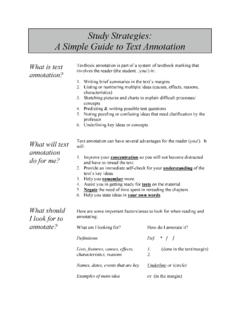Transcription of CHAPTER 6: CAPILLARY PRESSURE
1 7- 1 chapter 7: CAPILLARY PRESSURE Objective To measure CAPILLARY PRESSURE of unconsolidated sand packs. introduction CAPILLARY PRESSURE is important in reservoir engineering because it is a major factor controlling the fluid distributions in a reservoir rock. CAPILLARY PRESSURE is only observable in the presence of two immiscible fluids in contact with each other in CAPILLARY -like tubes. The small pores in a reservoir rock are similar to CAPILLARY tubes and they usually containing two immiscible fluid phases in contact with each other. Thus CAPILLARY PRESSURE becomes an important factor to be considered when dealing with reservoir rocks. When two immiscible fluids are in contact with each other in a CAPILLARY tube, a clear interface exists between them.
2 This interface arises from interfacial tension effects. The interface is a curved surface and the PRESSURE on the concave side exceeds that in the convex side. This PRESSURE difference is known as CAPILLARY PRESSURE . In the presence of two immiscible fluids, one of them preferentially wets the tube surface and it is called the wetting fluid, the other fluid is the non-wetting fluid. CAPILLARY PRESSURE can be mathematically expressed as: wnwcPPP = ..(7-2) Where nwP and wP are the pressures of the non-wetting and wetting fluids across the interface, respectively. Figure 7-1 shows a CAPILLARY tube in contact with two immiscible fluids where the contact interface can be seen as well as a diagram of pressures throughout the system. 7-2 Figure 7-1. PRESSURE Relations in CAPILLARY Tubes for Air-Water and Oil-Water Systems.
3 (After Amyx et al 1960) An important expression relating the CAPILLARY PRESSURE with the radius of the CAPILLARY tube and the interfacial tension can be derived by balancing the pressures in the system including the hydrostatic and interfacial tension (considering a system with oil and water, where water is the wetting fluid): rcosPwowoc 2= ..(7-2) Where wo is the interfacial tension between the fluids, wo is the contact angle, and r is the CAPILLARY tube radius. Considering the same system presented in Figure 7-1 and Equation 7-1, it can be shown that the CAPILLARY PRESSURE is also related to the height at which the fluid rises inside the CAPILLARY tube. This relation is given by: ()ghPPPowwoc = = ..(7-3) Where oP and wP are the oil (non-wetting fluid) and water (wetting fluid) pressures across the interface, respectively; o and w are the oil and water densities, respectively; g is the acceleration due to gravity, and h is the height of the column of water in the CAPILLARY tube with respect to a reference point (in the case of Figure 7-2, the level of water in the large vessel).
4 7-3 CAPILLARY PRESSURE may also be described using a more complex equation called the Laplace equation: +=2111rrPc ..(7-4) Where cP is CAPILLARY PRESSURE , is interfacial tension, and 1r and 2r are the principal radii of curvature. Figure 7-2 shows the distribution and measurement of the principal radii. Figure 7-2. Idealized Contact for Wetting Fluid and Spherical Grains. (After Amyx et al 1960) Equation 7-4 suggests that the condition for zero CAPILLARY PRESSURE is the presence of a flat interface between the fluids, that is, the principal radii are infinite. In addition, note that as the wetting phase saturation increases, the principal radii increase and therefore, the CAPILLARY PRESSURE decreases. 7-4 From the equations presented so far, it can be seen that by estimating CAPILLARY pressures of a specific system it is possible to estimate fluids distribution in a reservoir (h) (or fluid contacts) as well as pore radius distribution (r).
5 Laboratory Measurements Examining Equation 7-2 it can be seen that the CAPILLARY PRESSURE directly depends on the wettability of the reservoir rock and the fluids present in the rock. If we assume that the pore radii distribution of the rock is unchanged from reservoir conditions to laboratory conditions then we can formulate an equation relating CAPILLARY pressures measured at laboratory conditions with CAPILLARY pressures at reservoir conditions: ( )rcosPwgwgLc 2= ( )rcosPwowoRc 2= ( )( )LcwgwgwowoRcPcoscosP = ..(7-5) Where the subscripts R, and L, refer to reservoir and laboratory conditions, respectively, and the subscripts wg and wo refer to water-gas as measurement fluids and water-oil, respectively. Note that Equation 7-5 only considers the change in interfacial tension and contact angle (that is the change in wettability) as the only difference between CAPILLARY pressures at laboratory and reservoir conditions; PRESSURE , temperature, and mechanical differences such as matrix and pores deformations may influence the CAPILLARY PRESSURE in a reservoir rock.
6 The CAPILLARY PRESSURE Curve It is impossible to use the equations presented so far (Laplace and CAPILLARY tubes) to calculate the CAPILLARY PRESSURE on porous media due to the complex structure of the pores. In laboratory, CAPILLARY PRESSURE is measured as a function of the saturation of the wetting phase. In this sense, 7-5 CAPILLARY PRESSURE can be viewed as the necessary PRESSURE to force non-wetting fluid to displace the wetting fluid in a CAPILLARY . In other words, imagine a water-wetted reservoir rock saturated by water and oil. By capillarity, the water tends to rise inside the rock pores due to the rock surface preference to this fluid. The height at which the water rises in the rock depends on the CAPILLARY PRESSURE between the water and the oil. If the water is to be forced out, a PRESSURE equal to the CAPILLARY PRESSURE must be applied in order to eject the water out of the CAPILLARY .
7 Rocks usually have pores of different radii . Therefore, a particular CAPILLARY PRESSURE will be associated with a specific set of pores having the same radius (see Equation 7-3); lower CAPILLARY PRESSURE will displace water out of bigger pores while higher CAPILLARY pressures are required to displace water out of smaller pores. Figure 7-3 presents a CAPILLARY PRESSURE curve as a function of water saturation for a water-oil fluids system. It is common to plot two curves, one for the drainage process (that is, the displacement of the wetting phase by the non-wetting phase) and one for the imbibition process (that is, the displacement of the non-wetting phase by the wetting phase. The imbibition curve presents lower CAPILLARY pressures for a fixed saturation than drainage curves because of the natural tendency of the wetting fluid to saturate the rock.)
8 Note that for the drainage curve a CAPILLARY PRESSURE greater than zero is required to force the non-wetting fluid into the rock ( Entry PRESSURE ). The difference between saturations at the end points of both curves is the residual saturation of the non-wetting fluid that is trapped inside the rock. 7-6 Figure 7-3. Imbibition and Drainage CAPILLARY PRESSURE Curves. (After Engler 2003) CAPILLARY PRESSURE Measurement in Unconsolidated Sand Packs In this experiment we will determine the drainage and imbibition curves for an unconsolidated sand pack. We will use water as the wetting phase and air as the non-wetting phase. Figure 7-4 is a sketch of the CAPILLARY PRESSURE apparatus, which consist of a fritted plate funnel, a flexible hose, a graduated burette, and a yardstick.
9 7-7 Figure 7-4. CAPILLARY PRESSURE Apparatus Procedure Fill the burette, tubing and funnel with water until the water level is just at the top of the porous plate and at the zero mark on the burette (zero mark on the burette and top of porous plate should be initially at same height). An air bubble may be entrapped below the diaphragm. To remove it, keep your finger on the open end of the burette, and squeeze the flexible tube connecting the funnel and the burette. You may need to repeat this a few times. This problem can be minimized if the porous plate is horizontal. Remove the excess water using a pipette. Raise the burette until approximately 40 ml of water has flowed into the funnel. The water in the burette will go down from the zero mark reading to the 40 ml reading in the burette.
10 Measure 80 ml of sand and slowly add it to the funnel and stir the sand continuously to remove trapped air bubbles. Level the surface of the sand as much as possible. Cover the funnel with a watch glass. 7-8 Lower the burette until the water level in the funnel is at the top of the sand or just below it. Note and record the burette reading at this point. This is your pore volume (look in the burette and record current level of water reading). Record the height of the top of the sand. This is your reference point for head readings. Lower the burette about 1 inch to increase the hydrostatic head. Wait around 1 minute to achieve equilibrium. Record the height of the water in the burette. Record the volume reading in the burette (It should be a lower reading than the initial reference reading because water has come in from the sand pack).
